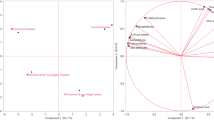Abstract
Coffee is known throughout the world for its distinct aroma and flavour which results from a number of volatile compounds present in it. It is very difficult to arrest the aromatic compounds once the roasting process is complete and it becomes even more challenging to store the beans for a longer time with the retained volatiles as these compounds are easily lost during industrialized processing such as the grinding of roasted coffee beans and storage of ground coffee. Thus, an attempt was made to minimise the loss of volatile from roasted coffee beans by coating with Carboxymethyl cellulose (CMC), Hydroxypropylmethyl cellulose (HPMC) and Whey protein concentrate. Coffee volatiles were analysed by Gas chromatography and 14 major compounds were identified and compared in this study. Results showed an increase in the relative area of major volatile compounds in coated roasted coffee beans when compared with unroasted coffee beans for consecutive two months. Moreover, effect of coating on textural properties and non-volatiles were also analysed. The results have indicated that edible coatings preserve the sensory properties of roasted coffee beans for a longer shelf life and cellulose derivatives, as an edible coating, exhibited the best protecting effect on roasted coffee beans.










Similar content being viewed by others
References
Belitz HD, Grosch W, Schieberle P (2009) Coffee, Tea, Cocoa. Vatican Springer, Berlin
Bendlin E, Chapman JM (2006) Characterization of roasted coffee bean aroma profiles by SPME. Analytical Chemistry General Posters
Briandet R, Kemsley EK, Wilson RH (1996) Approaches to adulteration detection in instant coffees using infrared spectroscopy and chemometrics. J Sci Food Agric 71(3):359–366
Buffo RA, Cardelli-Freire C (2004) Coffee flavor: an overview. Flavour Fragr J 19(2):99–104
Czerny M, Mayer F, Grosch W (1999) Sensory study on the character impact odorants of roasted Arabica coffee. J Agric Food Chem 47:695–699
Denis Fisk I, Kettle A, Hofmeister S, Virdie A, Kenny JS (2012) Discrimination of roast and ground coffee aroma. Flavour 1:1–8
Ekneet S, Bodhisattwa C (2011) Experiments and numerical modeling to estimate the coating variability in a pan coater. Int J Pharm 418(2):286–296
Fabra MJ, Hambleton A, Talens P, Debeaufort F, Chiralt A, Voilley A (2008) Aroma barrier properties of sodium caseinate based edible films. Biomolecules 9:1406–1410
Farah A, Donangelo CM (2006) Phenolic compounds in coffee. Braz J Plant Physiol 18:23–36
Fitter R, Kaplinksy R (2001) Who gains from product rents as the coffee market becomes more differentiated? A value-chain analysis. IDS Bull 32(3):69–82
Flament I (2002) Coffee flavor chemistry. British Library Cataloguing, London
Gardner J, Bartlett P (1999) Electronic Noses. Oxford Univ. Press, Oxford
Grosch W (2001) Coffee: Recent developments. In: Clarke RJ, Vitzthum OZ (eds) In Chemistry III: Volatile Compounds. Blackwell Science, Oxford, pp 68–89
Hennessy S, Downey G, Odonnell CP (2009) Confirmation of food origin claims by Fourier transform infrared spectroscopy and chemometrics: extra virgin olive oil from Liguria. J Agric Food Chem 57(5):1735–1741
Hindmarch I, Rigney U, Stanley N, Quinlan P, Rycroft J, Lane J (2000) A naturalistic investigation of the effects of day-long consumption of tea, coffee and water on alertness, sleep onset and sleep quality. Psychopharmacology 149:203–216
Illy A, Viani R (1995) Espresso Coffee: The Chemistry of Quality. Academic, London
International Coffee Organization (ICO) 2014 http://www.ico.org/
Jokanovića MR, Džinića NR, Cvetkovićb BR, Grujićc S, Odžakovićc B (2012) Changes of physical properties of coffee beans during roasting. APTEFF 43:21–31
Lyman DJ, Benck R, Dell S, Merle S, Murray Wijelath J (2003) FTIR-ATR analysis of brewed coffee: effect of roasting conditions. J Agric Food Chem 51(11):3268–3272
Maga JA (1978) Simple phenol and phenolics compounds in food flavour. Food Technol 10:323–372
Makri E, Tsimogiannis D, Dermesonluoglu EK, Taokis PS (2011) Modelling of Greek coffee aroma loss during storage at different temperatures and water activities. Procedia Food Sci 1:1111–1117
Marsili R (2010) Flavor fragnance and odour analysis, 2nd edn. CRC Press, Taylor and Francis group, Boca Raton
Nagaraju VD, Murthy CT, Ramalakshmi K, Srinivasa Rao PN (1997) Studies on roasting of coffee beans in a spouted bed. J Food Eng 31:263–270
Nagaraju VD, Ramalakshmi K (2002) Roasting of coffee beans in a spouted bed roaster. J Food Sci Technol 39:530–533
Nagaraju VD, Bhattacharya S (2010) Roasting green coffee beans using spouted bed roaster: changes in physical characteristics. J Food Sci Technol 47(6):674–677
NIST/EPA/NIH (1995) Mass spectral library: Standard reference database A. National Institute of Standards and Technology, Gaithersburg
Pranoto Y, Marseno DW, Haryadi X (2009) Methylcellulose and hydroxyprophyl methylcellulose-based coatings on partially defatted peanut to reduce frying oil uptake and enhance oxidative stability. As J Food Ag-Ind 2(04):891–900
Schenker S, Handschin S, Frey B, Perren R, Escher F (2000) Pore structure of coffee beans affected by roasting conditions. J Food Sci 65(3):452–457
Sobésa Café (2008) Available at: http://www.sobesa.com.br
Socrates G (1994) Infrared Characteristic Group Frequencies. John Wiley, New York
Yeretzian C, Jordan A, Lindinger W (2003) Analysing the headspace of coffee by proton-transfer-reaction mass-spectrometry. Int J Mass Spectrom 223–224:115–139
Acknowledgments
Authors thank the Director of CSIR-CFTRI for giving kind permission to publish this paper.
Author information
Authors and Affiliations
Corresponding author
Rights and permissions
About this article
Cite this article
Rattan, S., Parande, A.K., Ramalakshmi, K. et al. Effect of edible coating on the aromatic attributes of roasted coffee beans. J Food Sci Technol 52, 5470–5483 (2015). https://doi.org/10.1007/s13197-014-1707-x
Revised:
Accepted:
Published:
Issue Date:
DOI: https://doi.org/10.1007/s13197-014-1707-x




